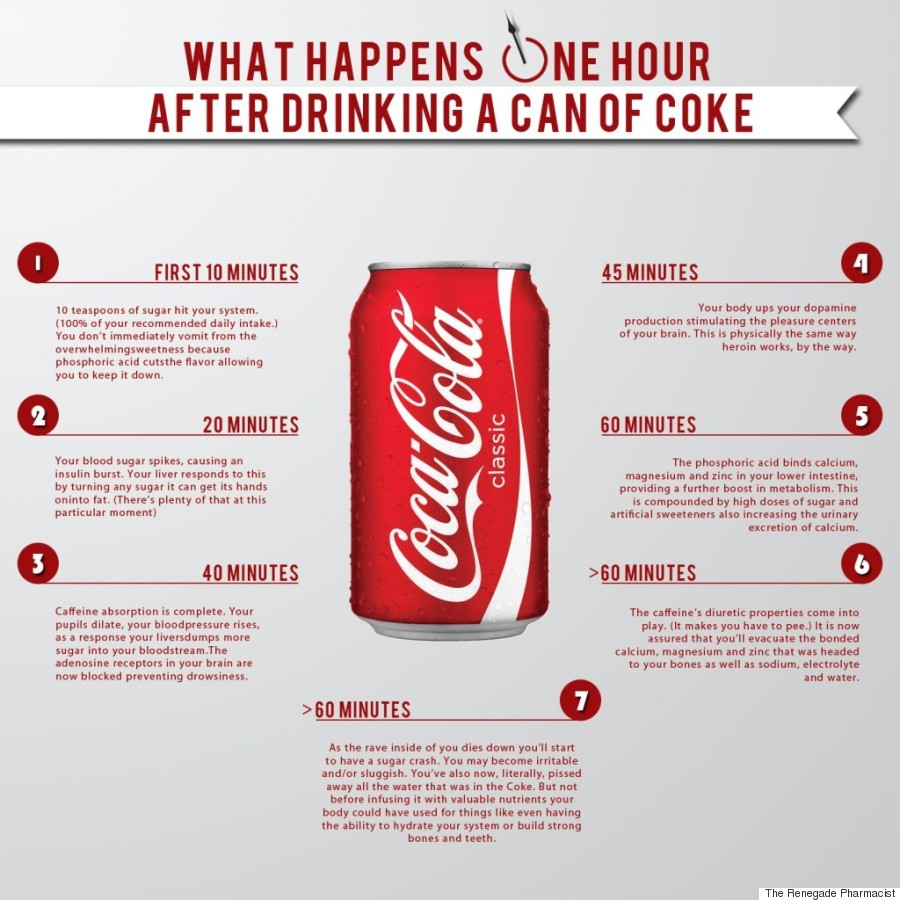Update: Here's What Coca-Cola Really Does to the Inside of Your Body

By:
It turns out, a viral infographic that swept the internet may have misdetailed just how harmful the effects of Coca-Cola really are, according to Buzzfeed.
Niraj Naik, a former pharmacist who started the blog The Renegade Pharmacist, recently created an infographic that details what happens to your body within an hour of drinking Coca-Cola. Many are talking about the image, as it apparently claimed to shed light on some scary truths behind soda and Coca-Cola consumption. However, not everything mentioned in graphic is true, in fact, it seems as though the science is confused, according to Buzzfeed's report with experts.
Claims about how sugar would make you barf if it weren't for the phosphoric acid that makes the taste in your mouth less sweet, or comparing caffeine as something that induces the same dopamine production as heroin reacts in the brain, are among some general overstatements included in the graphic, an expert told Buzzfeed.
 The Renegade Pharmacist - therenegadepharmacist.com
The Renegade Pharmacist - therenegadepharmacist.com
On his site, Naik explains that he developed an interest in learning more about health and weight during his time as a pharmacist.
"After seeing so many people suffering from obesity related diseases like heart disease, diabetes and the side effects of the medication they were taking, I was strongly motivated to research what actually causes people to become obese, it clearly was not just the fat they were eating! I actually discovered that a trigger factor for many widespread diseases of the west such as obesity, heart disease and diabetes could be closely linked to the consumption of one particular substance found in many processed foods and drinks – fructose in the form of high fructose corn syrup."
Buzzfeed reached out to Naik. He explained his original intention was to show how “big brands target children to create an association with them from an early age that is very hard to break later on.”
He explained that although he created the infographic, he did not create the content in it. He said it came from a published post on Blisstree.
“I don’t know exactly how accurate that infographic is for every single person as I was not the original creator of the content, but if you study each ingredient you will find they are metabolised with similar effects that will vary for each individual,” he wrote in an email. “Moderation is key.”
Fewer people are saying "yes" to soda
It's well-known that soda can be very bad for you and spark a host of different conditions such as diabetes and obesity. As obesity rates in the U.S. increase, however, more and more Americans are turning away from the dangers of soda. Earlier this year, ATTN: reported on new Beverage Digest findings that revealed a 29-year low in soda consumption, and fellow soda industry tracker Beverage Marketing found Americans consumed just 12.76 billion gallons of soda in 2014, marking a one percent drop and soda's tenth consecutive year of decreased consumption.
According to the findings, water bottle consumption has increased nearly 7.5 percent over the past two years as Americans have started saying "no" to soda. Coke Zero, which famously boasts zero calories, has seen a dip in volume and fallen back to the third most popular soda. Beverage Marketing expects water bottle consumption to surpass soda consumption within a few short years.
What soda is up against
Sugar drinks have been connected to obesity and poor dental health, among many other risks. Two years ago, General Dentistry released a troubling report that found years of drinking diet soda can do similar damage to the teeth as years of meth or cocaine smoking. Acid erodes tooth enamel, putting teeth at greater risk of getting cavities, developing cracks, discoloring, and sensitivity.
The soda industry also has to compete with other tasty drinks that have few to no calories: flavored Vitaminwater, various brands of coconut water, and other juices that better hydrate drinkers. Last year, instant coffee went up 11 percent, suggesting Americans are moving towards convenient, low-calorie coffee for their caffeine fix.
What obesity costs the U.S.
In the spring, public policy nonprofit the Brookings Institute and the World Food Center of the University of California-Davis found the societal cost of obesity could be more than $1.1 trillion if the 12.7 million obese children in America remain obese as adults.
Discussing the findings earlier this year, UC-Davis Chancellor Linda P.B. Katehi talked about obesity's negative impact on social mobility and different communities.
"We all know that obesity makes people very sick," Katehi said. "It destroys communities in many ways and makes them less productive, and of course it has [a] great impact on the economies of these communities. As we know, especially in the United States, our economy is based on small and medium-sized companies and in communities that aren't very healthy, you see much less of that, and of course the economy in those areas suffer tremendously. You see the impacts of that: lack of health, low economy in the quality of the schools, the quality of education that the students receive, and eventually their ability to move socially upwards, which is something we as an institution have tried to achieve."
Katehi pointed out that access to healthy food and and education are "critically connected," saying that even those who work in California's agriculture industry don't necessarily get to eat quality food themselves.
